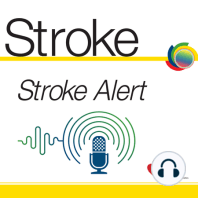21 min listen
Stroke Alert July 2021
FromStroke Alert
ratings:
Length:
38 minutes
Released:
Jul 15, 2021
Format:
Podcast episode
Description
On Episode 6 of the Stroke Alert Podcast, host Dr. Negar Asdaghi highlights two articles from the July 2021 issue of Stroke: “Prevalence and Clinical Correlates of Intracranial Dolichoectasia in Individuals With Ischemic Stroke” and “Dose Escalation and Safety of Capsaicin for Cerebral Perfusion Augmentation.” She also interviews Dr. Osama Zaidat about his article “Impact of Age and Alberta Stroke Program Early Computed Tomography Score 0 to 5 on Mechanical Thrombectomy Outcomes.” Dr. Negar Asdaghi: 1) Is intracranial dolichoectasia the new intracranial atherosclerotic disease? 2) What is the latest on collateral flow improvement through sphenopalatine ganglion stimulation in patients with acute ischemic stroke? 3) Is endovascular therapy futile in patients presenting with a low ASPECTS score? These are the topics that we will cover in today's podcast. You're listening to the Stroke Alert Podcast. Stay with us. Dr. Negar Asdaghi: From the Editorial Board of Stroke, welcome to the Stroke Alert Podcast. My name is Negar Asdaghi. I'm an Associate Professor of Neurology at the University of Miami Miller School of Medicine and your host for the monthly Stroke Alert Podcast. Dr. Negar Asdaghi: For the July 2021 issue of Stroke, we have a systematic review and meta-analysis of safety and efficacy of dual antiplatelet therapy with P2Y12 inhibitors and aspirin versus aspirin monotherapy in patients with mild ischemic stroke or high-risk transient ischemic attack, which I encourage you to review in addition to today's podcast. Dr. Negar Asdaghi: Later in the podcast, I have the pleasure of interviewing Dr. Osama "Sam" Zaidat, Professor of Neurosurgery and Neurology at Bon Secours Mercy Health Neuroscience Institute. Dr. Zaidat will speak to us about his work on endovascular therapy in patients presenting with a large ischemic core as determined by a low ASPECTS score on presentation. But first with these two articles. Dr. Negar Asdaghi: In the setting of acute ischemic stroke, intracranial large-vessel disease is often equated with processes which result in narrowing of the intracranial vessels, such as what is seen in the setting of intracranial atherosclerotic disease, or ICAD, where much research has focused on the degree of noumenal stenosis. Less is known about intracranial dolichoectasia, or IDE, which is characterized by ectasia, that is dilation, or dolichosis, which is increased length or tortuosity of the intracranial arteries. Dr. Negar Asdaghi: IDE can occur due to inflammatory, infectious, or genetic abnormalities. But much like its stenotic counterpart, or ICAD, most cases of IDE are diagnosed in the setting of uncontrolled vascular risk factors. Keeping in mind that the pathophysiology of ICAD and IDE are entirely different. Dr. Negar Asdaghi: Despite recent advances in recognition of IDE beyond an arteriopathy involving the basilar artery alone, the prevalence of IDE in patients with acute ischemic stroke is unknown, in part related to the lack of a unified diagnostic criteria for this condition. In this issue of the journal, Dr. Victor Del Brutto from the Division of Cerebrovascular Disease at the University of Miami and colleagues studied the prevalence and clinical correlates of IDE among 211 consecutive acute ischemic stroke patients admitted to a tertiary care hospital during a four-month period. IDE was defined as either ectasia or dolichosis of at least one proximal intracranial artery equal or greater than two standard deviations from the study population mean as measured by semi-automated segmentation method. Dr. Negar Asdaghi: So, what they found was that IDE was identified in 24% of stroke cases: a small percentage, which was only 5%, with only isolated ectasia; 9.5% with isolated dolichosis; and the rest with both ectasia and dolichosis. Anterior and posterior circulation were equally involved, but not surprisingly, the basilar artery was the single most
Released:
Jul 15, 2021
Format:
Podcast episode
Titles in the series (39)
Stroke Alert May 2021: Monthly summary & analysis of selected research published in the Stroke journal by Stroke Alert
